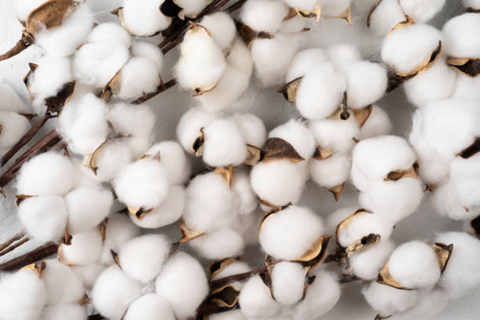 A Guide to Washing Natural Fiber Fabrics
Tuesday, July 5 2022
A Guide to Washing Natural Fiber Fabrics
Tuesday, July 5 2022

Cotton
Fiber properties: Cotton is a soft, short staple, hollow plant fiber that produces a cool, breathable fabric. It is absorbant, and can wick moisture, making it a good choice in hot weather.
Care Instructions: Cotton should be washed in cool to warm water, and can be dried in a dryer. It can also be pressed with an iron on the cotton setting, with or without steam. Please note that cotton can tolerate hot temperatures if needed, but using hot water can cause it to shrink, especially the first time it is washed.

Wool
Fiber properties: Wool is an animal fiber from sheep that has insulating properties and naturally repels water, making it feel warm even when wet. Wool fibers have scales that can become interlocked permanently with heat, moisture, and soap - this is called felting. Felting wool can produce great results for a firm and sturdy fabric; but unless you intend to felt your wool, care must be taken when washing it.
Care Instructions: Wool is not heat tolerant. To wash wool fabrics by machine, use cold water and the gentlest cycle and detergent. Wool can also be washed gently by hand, using cold or lukewarm water. When washing by hand, squeeze out the excess water (do not wring). Hang or lay flat to dry. Pressing wool is not recommended. If pressing is necessary, use the wool setting and steam. Wool garments should be pressed inside out, using a press cloth.

Hemp/Linen
Fiber properties: Hemp fabric is a strong, durable fabric made from the long fibers from the stems of the hemp plant. It is absorbant, mildew resistant, and gets softer with use. Linen is produced from the long fibers of the flax plant stem and has similar properties to hemp.
Care Instructions: Hemp and linen should be washed in cool or warm water, using a gentle detergent. These fabrics can be air dried or dried in a dryer, but when a dryer is used the fabrics should be removed before completely dry, and hung or laid flat to finish drying. If hemp or linen require pressing, it is best to leave the fabric damp and use a press cloth and the linen setting on your iron.
Hemp/Cotton Blends
Fiber properties: Blending hemp and cotton results in a fabric that combines the best properties of both fibers. Hemp and cotton blends are more durable than 100% cotton, and adding cotton helps to soften the hemp fabric.
Care Instructions: Hemp Cotton blends can be washed and dried the same way as 100% Hemp fabrics.

Silk and Hemp/Silk Blends
Fiber properties: Silk fabric is made from the cocoons of silk worms, producing a luxurious and drapey fabric. Peace silk is made using cocoons from which the silk moths have emerged, so it is spun rather than reeled. Hemp/silk blends combine the lustrous qualities of silk with the durability of hemp, producing beautiful and useful fabric.
Care Instructions: Silk and hemp/silk blends should be handwashed in cool water with a few drops of gentle detergent. The fabric should be swished gently and the water gently squeezed out - avoid rubbing or wringing. Repeat with clear water to rinse. Hang or lay flat to dry. If your silk fabric requires pressing, use the lowest heat setting and a press cloth. Press each section, then lift the iron and press the next section.
General Fabric Care Tips
Testing: When in doubt, wash a test swatch to be sure you will be getting the results you want.
Prewashing: Check out our blog post on prewashing your fabrics.
Stains: Avoid the use of bleach or enzyme-based stain removers - these can weaken the fibers of your fabric and shorten its life.
Durability: Washing and drying contribute to wearing out fabrics. The life of textiles can be extended by only washing when needed, and using the coolest temperatures and gentlest cycles necessary when washing. Avoid using a dryer if possible because dryers also wear out textiles: fibers from textiles end up in the lint trap!
Preservation: Check out our blog post 7 Steps for Keeping Garments and Household Textiles Out of the Landfill to find out how to extend the life of your natural fiber clothing or other textiles when they start to wear out, and what to do when the are worn out.
1 Comment:

















 Same day shipping for most orders
Same day shipping for most orders Questions? Call us toll-free at: 1-855-SEW-PURE
Questions? Call us toll-free at: 1-855-SEW-PURE

Your article is very inspiring with high-quality content. We are sure that you will find additional useful information on our website. Come on, visit us at baju seragam kerja and we can collaborate with each other.
Warm Regard.